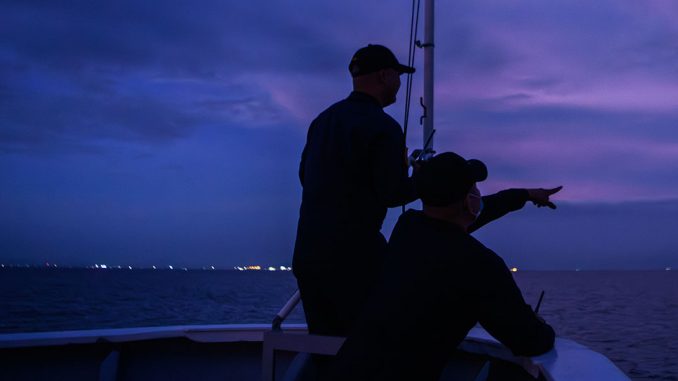
Chinese leader Xi Jinping last week told the communist regime’s coast guard simply to enforce maritime law, but we all know what that really means—and it has nothing to do with upholding the rule of law on the high seas.
Chinese vessels collided last month with a Philippine resupply boat and a Philippine coast guard ship within the span of a few hours. These confrontations were the latest of many between the two countries over competing territorial claims to a submerged reef called the Second Thomas Shoal, a military outpost in the Spratly Islands some 120 miles from the Philippines.
This situation underscores the need for America to adopt a robust response in the region and defend its treaty allies from Chinese bullying—before the situation escalates into the next major international conflict.
The Second Thomas Shoal is the site of a critical yet unorthodox Philippine military outpost in the form of a World War II warship run aground on the Spratly Islands, equipped with relatively few marines. The ship’s presence maintains Philippine sovereignty over the shoal, but the vessel remains a liability; its dilapidated state requires frequent resupply missions.
In fact, international scrutiny has grown with the belief that the grounded ship may fall off the reef and sink, allowing China to seize the shoal.
Philippine resupply missions are fodder for increasingly aggressive Chinese vessels that attempt to isolate the post, including the two collisions last month.
It’s not new that Chinese ships operate within the Second Thomas Shoal, the Spratly Islands, and the Philippine Exclusive Economic Zone. China increasingly has used its “maritime militia” to conduct illegal, unreported, and unregulated fishing as well as coercive activities against others who claim the South China Sea.
To date, China has used everything from warships and cutters to fishing boats to harass and intimidate the Philippines and other regional actors.
In October, for example, a Chinese naval vessel followed and attempted to cross in front of a Philippine resupply ship near the Spratly Islands. In September, the Philippines accused China’s maritime militia of damaging coral reefs in the Spratly Islands.
In August, a Philippine military supply boat en route to the shoal reportedly was blocked by Chinese coast guard vessels using water cannons. In July, the Philippines noted almost 50 Chinese fishing ships “swarming” around a reef in the Philippines’ Exclusive Economic Zone.
And in April, a Chinese coast guard ship came alarmingly close to colliding with a Philippine patrol vessel heading toward Second Thomas Shoal.
China’s escalation from using fishing boats to deploying naval and coast guard ships and increasing the frequency of these dangerous encounters is a clear warning signal that Xi is taking off the gloves. Now that China has succeeded in physically preventing supplies from reaching the shoal, what will its next moves be?
Although the Second Thomas Shoal is over 8,000 miles from the U.S. mainland, China’s belligerent actions there have major implications for America. The Philippines, with a shared wartime experience, is a longstanding treaty ally with which we have enjoyed strong relations for over 75 years.
During Oct. 22 discussions, Manila and Washington explored the possibility of conducting joint maritime patrols in the South China Sea. The U.S. government has reiterated that any action against Philippine territory in the South China Sea, including islands and shoals claimed by China, would be covered by the U.S.-Philippines mutual defense treaty.
Consistent with this, the U.S. could consider joint resupply missions and engage in a persistent, robust naval presence surrounding the shoal.
A lacking response to China’s prior provocations enabled and empowered Xi to pursue the escalations seen today. China’s illegal fishing and maritime bullying activities in neighbors’ waters are a litmus test to gauge the willingness of the United States and the international community to uphold and enforce maritime law.
America must do a better job of matching Chinese aggression with steadfast deterrence while highlighting China’s blatant violations of international law.
As The Heritage Foundation has pointed out, the U.S. is in a new Cold War with China. The U.S. should help the Philippines develop better airlift capabilities for resupplying and also shadow Philippine ships to deter China from interfering during resupply missions.
What’s happening at the Second Thomas Shoal is a harbinger of events to come if the U.S. permits this multipronged Chinese pressure campaign to destabilize Indo-Pacific security and international law to go unchecked.
Have an opinion about this article? To sound off, please email letters@DailySignal.com, and we’ll consider publishing your edited remarks in our regular “We Hear You” feature. Remember to include the URL or headline of the article plus your name and town and/or state.

